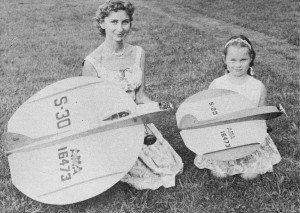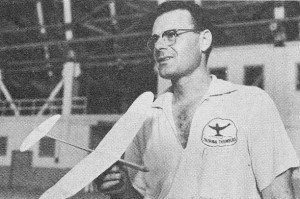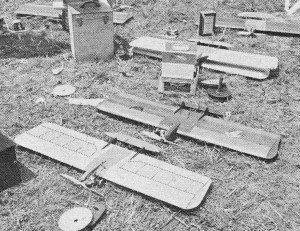|
An
extensive article introducing non-modelers to aircraft modeling
appeared in the Annual Edition of the 1962 American Modeler magazine.
15 pages were devoted to describing just about every aspect of model
building and flying - free flight gas and rubber; control line stunt,
combat, scale, and speed; helicopters and ornithopters; indoor gliders,
stick and tissue, and microfilm; even some early radio control.
In order to keep page length here reasonable (because of all
the images), the article is broken into a few pages. Pages:
|
10 & 11 |
12|
13 |
14 |
15 |16
|
17 |
18 |
19 |
20 |
21 |
22 |23
|
24 | For Non-Modelers: All About Air Modeling
20 Easy Ways to Go Crazy! <previous> <next>

Four favorite "models" belonging to George Wilson Jr. (Walpole,
Mass.) include full-size radio control Canadian Saucer from
A.M. and 20" free flight version. Mrs. Wilson with daughter
June completes favorite foursome.

This indoor hand-launched balsa won the Nationals for Jack Block
with time of 69.2 seconds.

Control line combat "fighters" employ simple constructions;
there are Mexican contenders.
Another non-contest scale model slowly gaining popularity is the
ducted-fan powered type. These are scale models of modern jet fighters
having 1/2A engines driving small diameter impellers instead of
propellers. Engine and impeller is enclosed within fuselage structure
resulting in clean scale appearance. Thrust output of the ducted
fan is relatively low so that very lightweight free flight construction
must be used. With the rapidly expanding popularity of radio
control model flying a contest category for flying scale R/C models
has recently been established. This is the ultimate in flying scale,
to be able to control the model through take off, flight and landing
- "look ma, no hands!" R/C scale models follow the usual
pattern of R/C construction and design. They are like rugged free
flights and in addition are able to carry the radio payload and
are finished and decorated like their scale prototypes. There are
no limitations on engine, model size or R/C equipment in competition
flying. Models are judged for scale fidelity and workmanship as
in other flying scale events. Bonus points are awarded for scale
operating features and models must demonstrate R.O.G. take off,
straight flight, procedure turn, straight return flight, figure
eight, rectangle and landing. Scale monoplane and biplane
types are favored, .09 to .35 engines powering 3 to 5 ft. span models
being popular sizes. RADIO CONTROL - Most
advanced phase of all model flying, radio control combines many
of the features of free flight and control line with the big added
attraction of true remote control-"no strings attached". The models,
though specialized designs, have typical free light structures somewhat
beefed up and control system linkages similar to those used in control
line models. Early radio control models were usually converted
free flight cabin designs. Few modelers tackled radio control flying
because a radio operator's license was required by Federal law.
This involved lengthy examination and training in radio theory.
These stifling FCC requirements have since been changed, so that
now anyone can use approved factory built model radio control equipment
without being a "ham". Transmitters are "registered" with the FCC.
This lifting of Federal requirements snowballed interest
in radio control modeling. Rapid advances in the electronic field
have been mirrored in model radio control equipment. We now have
units weighing a few ounces that once weighed pounds, thanks to
the transistorized circuits employed. The most advanced (and expensive)
model R/C equipment compares ir1 performance and reliability with
that used by the ices in target drones and missiles. A typical
"full-house" control system, model and engine represents an investment
of about $300 flying around in the air. Add another $100 plus for
transmitter, batteries and ground test equipment and the price tag
becomes pretty steep: But don't lose heart, it's a matter of the
more .controls, the more the expense. At the other end of the scale
you can put up a small single control R/C model for under $100.
Typical simple R/C trainers have about 4 ft. wing span and
are powered with .09 or .15 engines-many kits are available for
this and more advanced types. There are smaller models with 1/2A
power and even Pee-Wee .020 powered 2-footers that can be flown
inside a high school gym. The small trainer or sport types utilize
the simplest R/C equipment. A single control, the rudder, is operated
by radio.
Basically
the small "rudder-only" R/C model is a stable free flight design
usually of high-wing cabin type. The R/C equipment needed consists
of a battery powered handheld transmitter on the ground and in the
model, a small receiver with hearing-aid batteries for power, a
rubber-powered self-neutralizing escapement and linkage to move
the rudder. The R/C model is underpowered by VTO free flight standards
but this produces a shallow rate of climb and climb flying speed
is close to gliding speed. Model is trimmed for straight flight
and rudder control is used to steer model into and out of flat turns
in the air-space around the flyer. By holding rudder hard over,
model can be made to spiral dive picking up considerable speed.
When opposite control is given model will straighten out and recover
in a zoom. The excess speed and zoom can be used to perform other
fancy maneuvers by proper timing of rudder control signals. Enough
fuel is carried for prolonged engine runs of 2 to a minutes. When
fuel is used up, model can be steered in the glide down to a landing.
Radio control flying requires open space comparable to that needed
for free flight flying, but small models can be flown within the
confines of a football field in calm weather. In addition
to transmitter, receiver and other model control equipment, test
meters are needed for ground checks of battery voltage and receiver
and transmitter tuning. Add to the list plastic tuning wands, wire
strippers, resin-core solder and small soldering iron for assembling
wiring circuits. <previous> <next>
Posted December 25, 2010
|